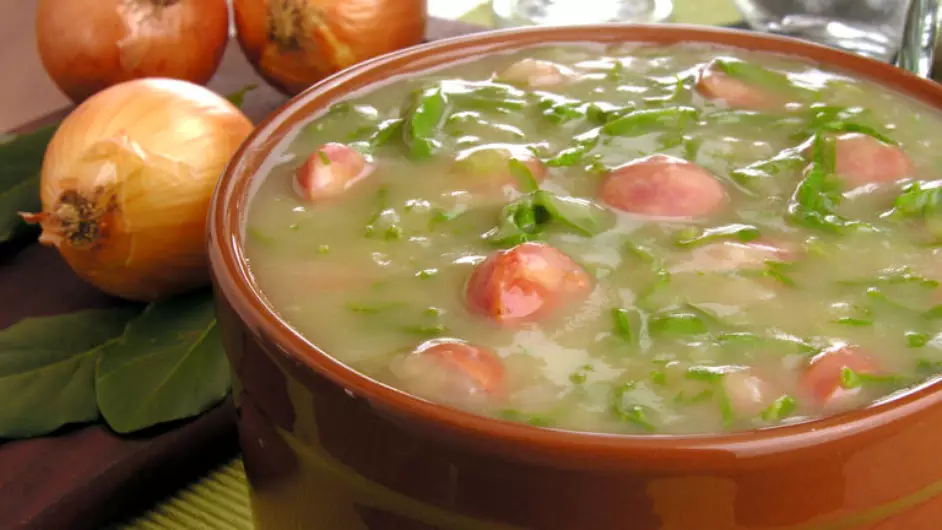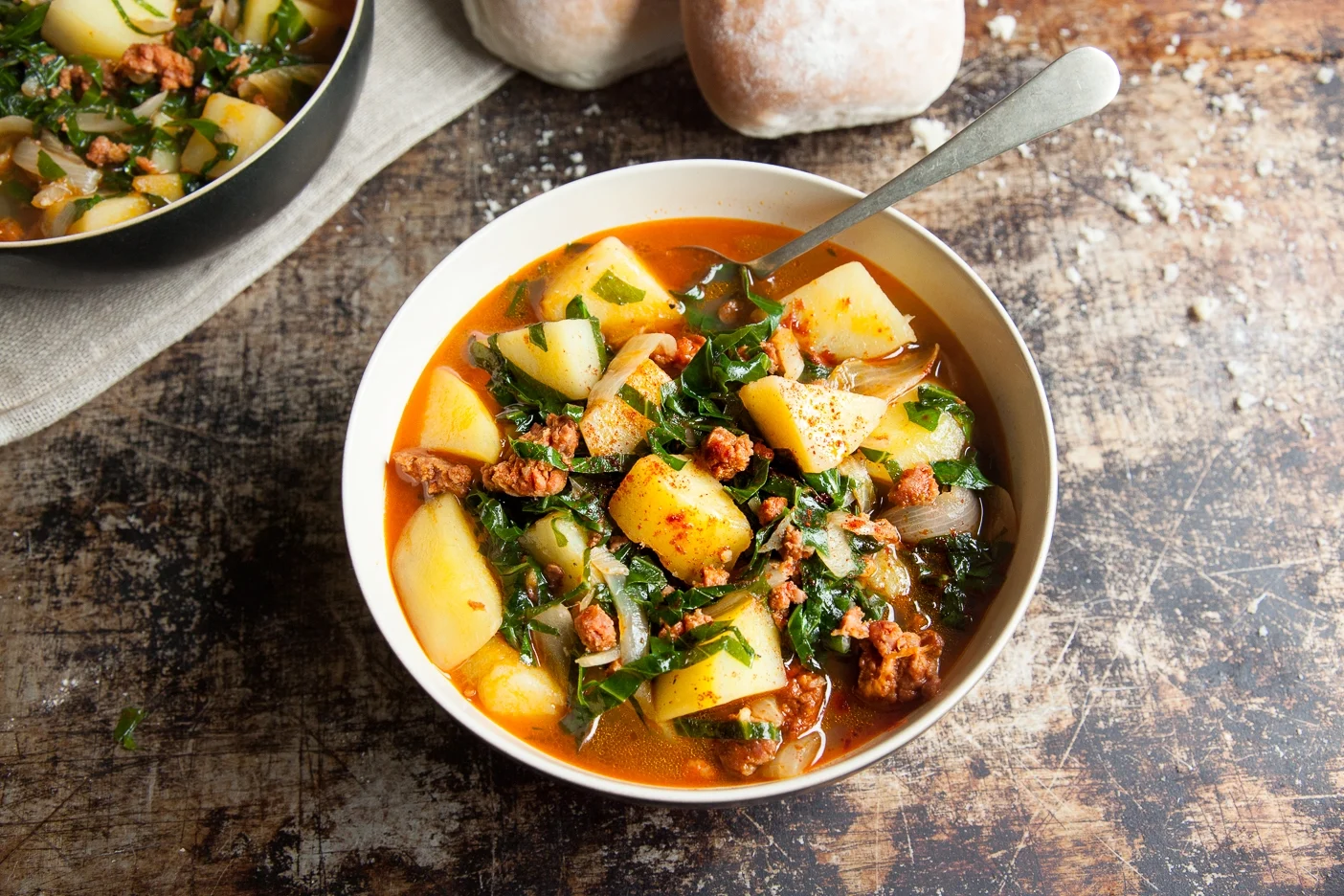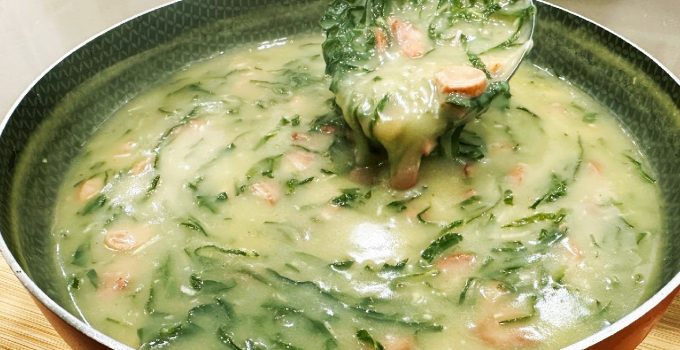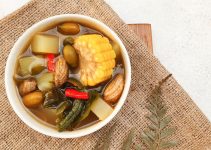Caldo Verde, a traditional Portuguese soup renowned for its simplicity and depth of flavor, holds a cherished place in the country’s culinary heritage. With its humble origins rooted in rural Portuguese communities, Caldo has evolved into a beloved national dish enjoyed by locals and visitors alike. In this article, we embark on a culinary journey to discover the origins, ingredients, and cultural significance of Caldo Verde, celebrating its status as a symbol of Portuguese culinary tradition.

Caldo Verde
Origins and Evolution
The origins of Caldo Verde can be traced back to the Minho region of northern Portugal, where it was traditionally prepared by farmers and villagers using ingredients readily available in the local countryside. Originally a simple peasant dish, Caldo Verde has since gained popularity throughout Portugal and beyond, becoming a staple of Portuguese cuisine and a symbol of national identity.
Key Ingredients and Preparation
At its core, Caldo Verde is a hearty soup made from a few basic ingredients: potatoes, collard greens, onions, garlic, and chorizo or another type of smoked sausage. The soup’s signature flavor comes from the combination of these ingredients, with the collard greens adding a rich, earthy flavor and the chorizo infusing the broth with smoky, savory notes.
To prepare Caldo, potatoes are boiled until tender and then mashed or pureed to create a creamy base for the soup. The collard greens are thinly sliced and added to the pot, where they cook until wilted and tender. Meanwhile, the chorizo is typically sliced and fried until crispy before being added to the soup, imparting its distinct flavor to the broth.
Cultural Significance and Popularity
Caldo Verde holds a special place in Portuguese culture, often served at festive occasions, family gatherings, and community celebrations. It is a dish that brings people together, evoking a sense of warmth, comfort, and nostalgia for simpler times. In addition to its cultural significance, Caldo Verde is also valued for its nutritional benefits, providing a hearty and nourishing meal that sustains both body and soul.

Caldo Verde
Variations and Adaptations
While the basic recipe for Caldo remains consistent, there are variations and adaptations of the dish found throughout Portugal and in Portuguese communities around the world. Some versions may incorporate additional ingredients such as beans, carrots, or cabbage, while others may feature different types of sausage or regional spices. Despite these variations, the essence of Caldo Verde remains the same: a soul-warming soup that celebrates the bounty of the Portuguese countryside.
A Taste of Portuguese Tradition
Caldo Verde exemplifies the essence of Portuguese cuisine, with its simple yet flavorful combination of ingredients reflecting the country’s rural roots and culinary heritage. As a beloved national dish, Caldo serves as a source of pride and identity for the Portuguese people, embodying the warmth, hospitality, and rich traditions of their culture. Whether enjoyed on a chilly evening in Lisbon or served at a festive gathering in a Portuguese community abroad, Caldo Verde offers a taste of Portugal’s culinary tradition and a reminder of the power of food to nourish both body and soul.
Caldo Verde Soup: Unveiling its Strengths and Weaknesses
Caldo Verde, a traditional Portuguese soup cherished for its comforting flavors and rustic charm, has long been a staple in Portuguese cuisine. Its hearty combination of potatoes, collard greens, and sausage has won wdbos the hearts of many, both within Portugal and beyond. In this article, we delve into the merits and drawbacks of Caldo, exploring its nutritional benefits, cultural significance, and potential limitations as a culinary choice.

Caldo Verde
Advantages of Caldo Verde:
- Nutritional Richness: Caldo Verde boasts a nutritional profile that aligns with a balanced diet. Potatoes provide a good source of carbohydrates for energy, while collard greens offer essential vitamins and minerals, including vitamin K, vitamin C, and calcium. Additionally, the inclusion of sausage adds protein and flavor to the soup, making it a satisfying and nourishing meal option.
- Cultural Significance: As a quintessential dish of Portuguese cuisine, Caldo holds significant cultural importance for the people of Portugal. It is often enjoyed during festive occasions, family gatherings, and community celebrations, serving as a symbol of tradition, heritage, and shared culinary heritage. Its widespread popularity both within Portugal and among Portuguese communities worldwide underscores its enduring cultural significance.
- Ease of Preparation: Caldo Verde is relatively simple to prepare, requiring only a handful of basic ingredients and minimal cooking techniques. This simplicity makes it accessible to home cooks of all skill levels, allowing anyone to recreate the comforting flavors of this beloved Portuguese soup in their own kitchen. Whether served as a weeknight dinner or a hearty meal for guests, Caldo Verde offers a convenient and satisfying option for home cooking.
Disadvantages of Caldo Verde:
- High Sodium Content: One potential drawback of Caldo Verde is its relatively high sodium content, particularly when prepared with sausage or other processed meats. Excessive sodium intake has been linked to health issues such as high blood pressure and cardiovascular disease, making it important to consume Caldo in moderation and consider lower-sodium alternatives when possible.
- Caloric Density: While Caldo Verde is a nutritious meal option, it can also be calorie-dense, especially if consumed in large portions or accompanied by additional bread or side dishes. Individuals watching their calorie intake or trying to maintain a healthy weight may need to exercise portion control when enjoying Caldo Verde to avoid overconsumption of calories.
- Limited Variability: While Caldo simplicity is part of its charm, it may also be viewed as a limitation by those seeking more variety in their meals. The basic recipe for Caldo remains relatively consistent, with variations limited to the choice of sausage or the addition of other vegetables. For individuals accustomed to more diverse culinary experiences, the lack of variety in Caldo may become repetitive over time.
Conclusion: Embracing the Joys and Considerations of Caldo Verde
In conclusion, Caldo Verde offers a delightful combination of flavors, cultural significance, and ease of preparation that has endeared it to generations of Portuguese and food enthusiasts worldwide. Its nutritional benefits, cultural importance, and simplicity of preparation make it a beloved comfort food and a symbol of Portuguese culinary tradition. However, it is essential to be mindful of its potential drawbacks, including its sodium content, caloric density, and limited variability, when considering it as part of a balanced diet. By embracing the joys and considerations of Caldo Verde, one can fully appreciate its unique place in the culinary landscape and enjoy its comforting flavors with mindfulness and moderation.
Read More Article About “French Cooking: Classic Recipes for the Modern Chef“




